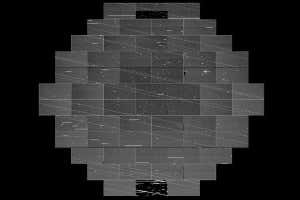
Cliff Johnson, Clara Martínez-Vázquez, DELVE Survey
Elon Musk’s SpaceX interfered with astronomy again, a few days after its second batch of Starlink satellites were launched.
SpaceX launched 60 new Starlink satellites into orbit on 11 November, bringing the total number of satellites it has in low Earth orbit up to 120.
After the first launch, in May this year, astronomers noted that the satellites were extremely bright, prompting concerns that the planned number of satellites could interfere with scientific research and views of the night sky.
Advertisement
The trail of the newly launched satellites interfered with astronomical observations at the Cerro Tololo Inter-American Observatory (CTIO) in northern Chile on 18 November. Astronomers were using the Dark Energy Camera (DECam), which can take images of large areas of the night sky in visible and near-infrared wavelengths of light.
“I am in shock,” wrote astronomer Clara Martinez-Vazquez at CTIO on Twitter, in reference to the Starlink satellites. “Our DECam exposure was heavily affected by 19 of them,” she tweeted. “The train of Starlink satellites lasted for over 5 minutes!”
Cliff Johnson of Northwestern University in Illinois posted a raw image taken from the DECam on Twitter, which shows bright oblique dotted lines created by the satellites (pictured).
The astronomers were taking observations as part of the DECam Local Volume Exploration Survey, which is imaging the entire southern sky to find dark matter-dominated galaxies.
The Cerro Tololo Inter-American Observatory is located just 20 kilometres north-west of the Large Synoptic Survey Telescope, a huge observatory currently under construction, which will map near-Earth asteroids, and study supernovae and dark matter. In June, it released a statement detailing the impact Starlink could have on its images of the entire southern sky, calling the satellites a “nuisance”.
The Federal Communications Commission, a US regulator, has given SpaceX permission to launch a total of nearly 12,000 satellites to provide broadband internet worldwide. Other companies such as OneWeb and Amazon also have plans for similar fleets of satellites.
Last month, SpaceX filed documents that showed it plans to launch 30,000 additional small satellites – roughly triple the number of satellites sent into space by humans to date.
There is presently no regulation that controls the brightness of satellites. The issue should be a concern not only for professional astronomers, says Michele Bannister at Queen’s University Belfast. “This is a problem for how we as a society appreciate the night sky.”
SpaceX says it will make the base of Starlink satellites black to help mitigate the impacts on astronomical observations, and will adjust satellite orbits if required. The firm says it is also working with astronomy groups such as the National Radio Astronomy Observatory and the Green Bank Observatory in the US to reduce the impact on astronomy activities.
More on these topics:





